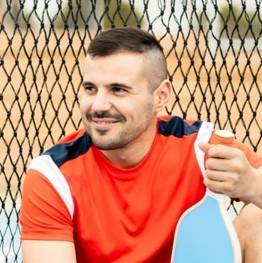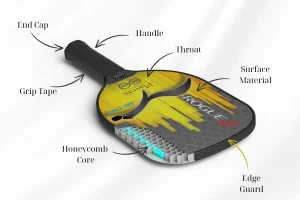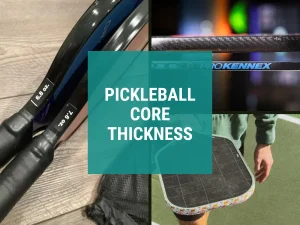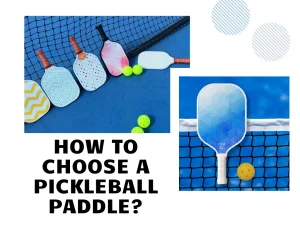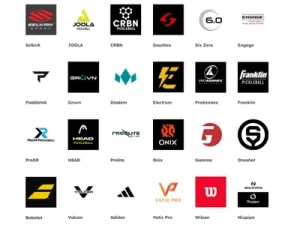While selecting the best pickleball paddle for you, you need to consider the paddle’s weight, shapes, and material. Determining the pickleball paddle material is crucial because it affects your performance and feel, and the paddle’s durability. If you choose the proper material, your paddle will help you improve your limited skills and perform better on the court.
Each material has specific benefits and drawbacks. This article will provide detailed knowledge of surface materials and core materials. As a result, it will help you have an overview of materials and know how they affect your power, control, spin, and comfort.
Common Materials Of Pickleball Paddles
Through Ask A Pickleball Pro, we usually get the question “What are pickleball paddles made of?“. For the answer, most pickleball paddles are made of a core and a surface material. Each affects the paddle’s different performance factors.
- Core materials will primarily impact a paddle’s weight and its feel and responsiveness.
- Surface materials will influence durability, control, and power.
A paddle would be designed with a bias toward control, power, or spin, dependent upon the materials used in its composition. This section will cover aspects of paddle materials such as structure, hands-on performance, and player references.
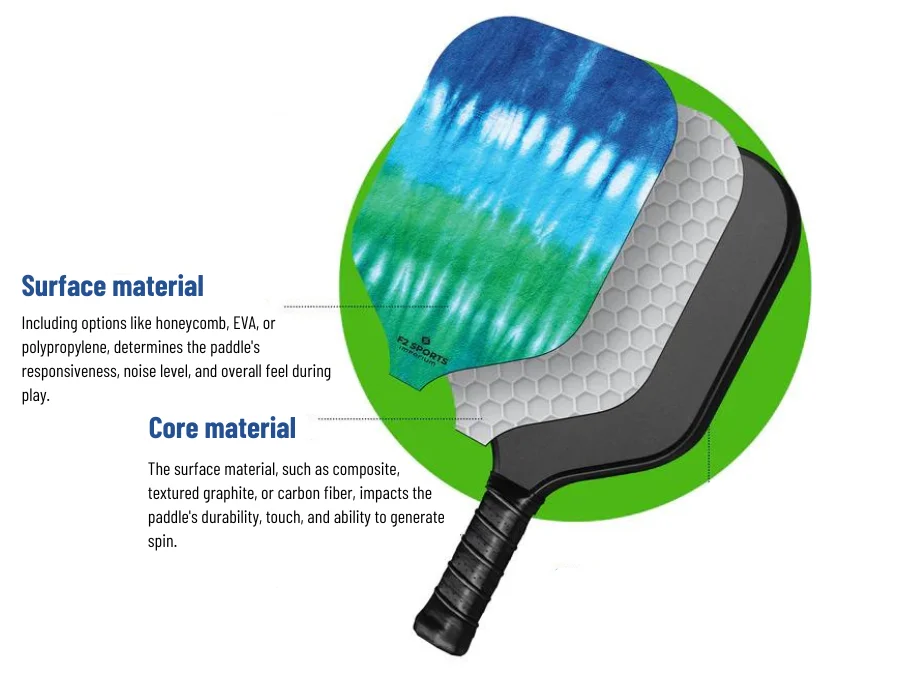
SURFACE MATERIAL
Graphite Surface
Graphite has a structure based on layers of rings with six carbon atoms bonded by single bonds. Carbon atoms are arranged in a hexagonal lattice bonded in a planar, creating horizontal panels spaced apart.
This structure creates a smooth, stable surface with a balance of durability and flexibility. These single bonds are often not sustainable. Thus, graphite has a light, hard structure but is brittle and fragile.
- Lightweight and easy to maneuver
- Excellent control and precision
- Reduces vibrations, enhancing comfort
- It provides a crisp, responsive feel
- It may offer less power compared to fiberglass
- You can feel less forgiving of mishits
- Less durable than carbon fiber
- Requires better skills to use effectively.
Who Should Use Graphite Surface
Graphite paddles are ideal for players seeking a balanced combination of control and touch. They are well-suited for intermediate to advanced players who prefer a lightweight paddle, and fluid movement on the court. If you focus on a refined feel and accuracy over raw power, graphite is a suitable choice.
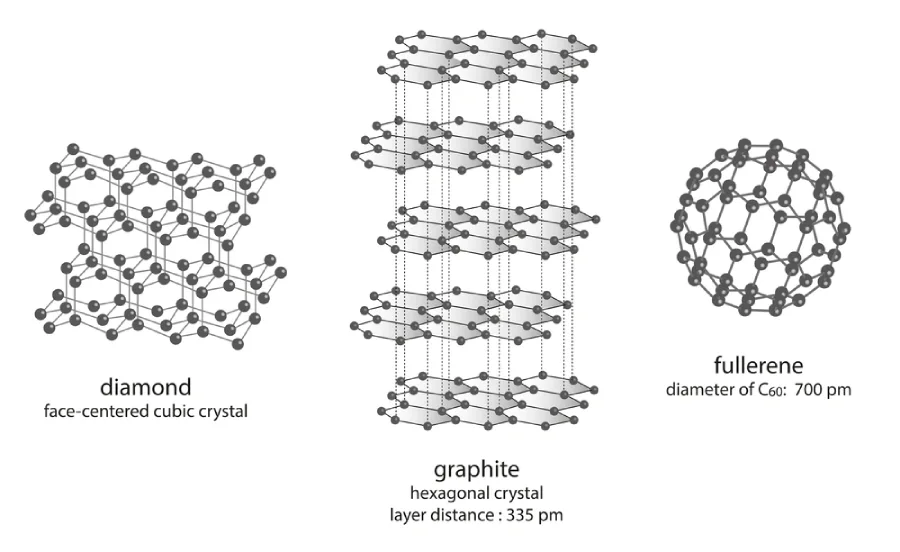
Carbon Fiber Surface
Carbon fiber is regarded as a kind of graphite due to structural similarities. Each carbon atom in the fiber forms strong covalent bonds with three other carbon atoms following an aromatic ring structure. After that, these strands are then woven into a fabric-like material and bonded with resin to create a highly rigid and durable surface.
Unlike graphite’s flat hexagonal layers, carbon fibers are made up of long, thin strands that are weaved together and linked. This structure creates a rigid, lightweight lattice, and a little more durable than graphite.
- Superior durable and strong
- Provides excellent power and responsiveness
- Lightweight for easy maneuverability
- Reduces vibrations for enhanced comfort.
- Typically more expensive than other materials
- Less forgiving on mishits
- It may have less touch and control compared to graphite
- Not ideal for beginners.
Who Should Use Carbon Fiber Surface
Advanced players who focus on precision and power in playing style would like carbon fiber paddles. The stiffness and high responsiveness of this material are ideal for people who need quick reactions and very accurate shot placement. The carbon fiber paddle is an excellent choice for competitive players looking for high performance.
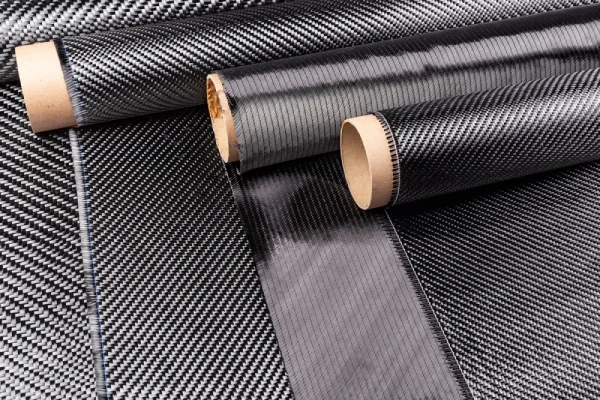
Fiberglass Surface
Fiberglass is often referred to as a composite material. It is made by weaving fine glass fibers into a cloth-like structure, which is then coated with resin. So, fiberglass is a durable, flexible, and lightweight material that is commonly used in a variety of sporting goods. Fiberglass surfaces are known for their smooth and enhanced strength.
While fiberglass is a type of composite material, not all composites are fiberglass. Composite paddles may include carbon fiber or graphite combined with fiberglass. Yet fiberglass provides distinct characteristics that make it a popular choice for paddle surfaces.
- Moderate power generation
- Provides excellent control
- Affordable and cost-effective
- Offers a softer touch and better feel for beginners.
- Heavier than graphite or carbon fiber
- Can wear out faster than carbon fiber or graphite
- Have a softer feel compared to graphite
- May not provide as much responsiveness.
Who Should Use Fiberglass Surface
Fiberglass paddles are ideal for intermediate players who seek a balance between control and power. They are well-suited for players who appreciate a softer feel and enhanced touch, without compromising on durability. Fiberglass paddles are also a great option for those transitioning from beginner to intermediate levels, providing a comfortable and reliable playing experience.
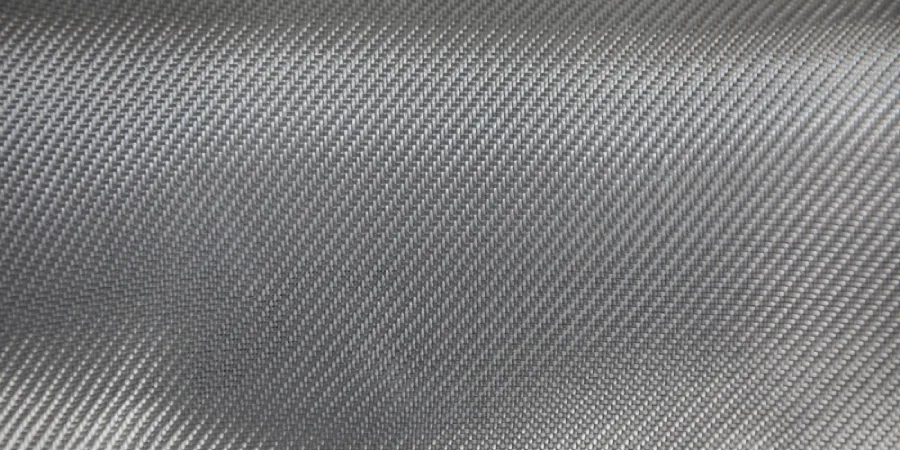
Kevlar Surface
Kevlar fiber is a type of aramid fiber known for its high durability, often used as bulletproof vests. Kevlar fibers are composed of long chains of molecules arranged in parallel, featuring aromatic (benzene) rings and amide bonds (-CO-NH-). The Kevlar fibers are weaved into a textile, which is then resin-bonded together to make a solid and hard paddle. This structure not only enhances the material’s durability but also distributes impact forces effectively, making the paddle resistant to impact. The result is a strong, lightweight paddle that can withstand intense play.
- Exceptional durability and impact resistance
- Provides a good balance of control and power
- Excellent shock absorption and comfort
- A high strength-to-weight ratio for a lightweight feel.
- More expensive than other materials
- It may not provide as much power as carbon fiber
- It can feel less responsive to fast shots
- Less common than other materials.
Who Should Use Kevlar Surface
Kevlar paddles work great for players whose concerns are durability, control, and high performance. They are well-suited for players who play frequently and need a paddle that can withstand heavy use. Kevlar paddles are also a suitable choice for advanced players looking for a balance between control and power with extra toughness.
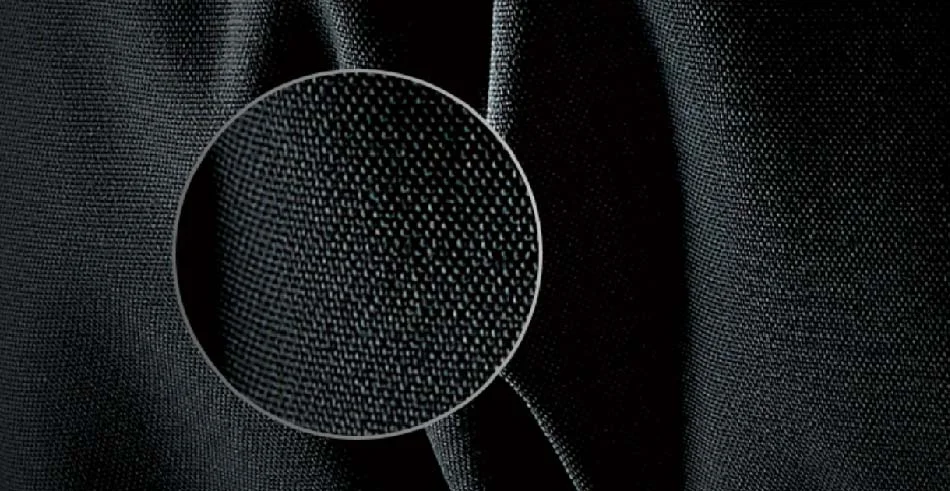
Hybrid Surface
Hybrid pickleball paddles combine two or more surface materials to utilize the strength of each. Most hybrid paddles have a combination of graphite, carbon fiber, or fiberglass in their construction. This multi-material construction aims to bring a balance in performance, bringing together what is considered the best from each material into one.
For instance, a hybrid paddle combines a graphite layer and a fiberglass layer. The graphite gives it enhanced stiffness and responsiveness, while the fiberglass offers flexibility and a softer feel. This will help balance between touch and power, overcoming the cons of these two separate materials.
- Combines the benefits of multiple materials
- It gives a well-balanced combination of durability, control, and power
- Often optimized for high performance and player comfort
- Improved durability and responsiveness.
- It can be more expensive due to the complex construction
- Not be as specialized as single-material paddles for specific needs
- Performance can vary depending on the specific hybrid combination.
Who Should Use Hybrid Surface
Hybrid paddles are ideal for players who want a versatile option that combines the benefits of multiple materials. They are well-suited for intermediate to advanced players looking for a versatile paddle that adapts to various playing styles and provides a balanced performance. This type of paddle is also suitable for players seeking to improve their game with a paddle that offers both power and control.
CORE MATERIAL
Honeycomb Structure
The core of a pickleball paddle is a part sandwiched between the paddle’s face materials, often having a honeycomb structure. The honeycomb core consists of a grid-like pattern of hexagonal cells, made from materials like polymer, Nomex, or aluminum. The honeycomb core is lightweight, strong, and durable. The trapped air within the hexagonal cells allows for better shock absorption, reducing vibration and improving touch and feel. This design also helps efficient energy transfer from the player’s swing to the ball, enabling powerful shots without requiring a heavier paddle.
Before honeycomb cores, pickleball paddles often used traditional core types such as solid or multi-layer cores. It was heavier and less effective in absorbing shock, reducing maneuverability and control. The honeycomb core’s improved technology allows manufacturers to adjust cell thickness and density to cater to various playing styles. This advanced technology revolutionized paddle design and increased the sport’s popularity.
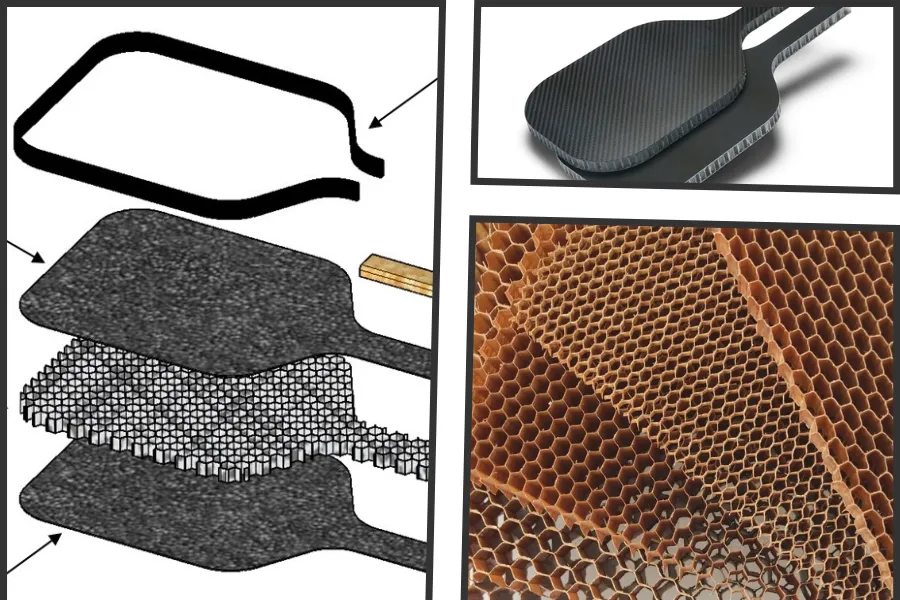
Polymer Core
Polymer core paddles use a honeycomb structure made from a high-density polymer, such as polypropylene. The honeycomb design consists of hexagonal cells. The walls of these cells are made from thin sheets of polymer bonded together to create a strong yet lightweight framework. This arrangement creates a strong, stable core that effectively absorbs impact and distributes force across the paddle surface. Besides, it also balances durability, flexibility, and impact resistance well. So polymer core is a popular choice for many pickleball paddles.
- Provides a superb balance between control and power
- Offers a softer feel and shock absorption
- Lightweight and highly durable
- Less noise compared to aluminum cores.
- It can wear out faster than high-density cores
- It may be less durable than Nomex cores
- It may not provide a high level of performance for advanced players.
Who Should Use Polymer Core
Polymer core paddles are ideal for players of all skill levels focusing on control, durability, and a consistent feel. They are especially suitable for players who experience arm or wrist discomfort, as the vibration-dampening properties. Beginners and intermediate players will benefit from the forgiving nature and durability. The advanced players can also appreciate the balance of performance features.
Nomex Core
Nomex is a type of aramid fiber with high strength and flame resistance. It consists of hexagonal cells similar to polymer cores, but this material is much stiffer and more rigid. The Nomex core is created by bonding thin material walls into a hexagonal cell pattern, forming a lightweight yet sturdy framework. This core design provides significant structural integrity while maintaining a relatively low weight. The Nomex honeycomb core offers a combination of rigidity and strength enhancing the paddle’s performance.
- Highly durable and resistant to deformation
- Excellent power and control
- Provides consistent, reliable performance
- Good at absorbing shock and impact, enhances paddle stability
- It can be stiffer, which might reduce comfort
- Produce more vibration compared to polymer cores
- Generally heavier than polymer cores
- Higher cost compared to other core materials.
Who Should Use Nomex
Nomex core paddles are best suited for advanced players focusing on power, durability, and a firm feel. They are ideal for competitive players who need a paddle that can handle aggressive play and provide consistent performance. The high rigidity and impact resistance make Nomex cores a good choice for players who value strength and durability in their equipment.
Aluminum Core
Aluminum is a lightweight metal providing high rigidity and strength. Yet it is not as durable as some other pickleball racquet materials and can be prone to deformation over time. Over time, the aluminum core can become compressed or bent, affecting the paddle’s performance.
- Offers an excellent blend of power and management
- Often offers a good balance of performance and feel
- Offers a crisp feel and responsive play.
- Prone to denting and deformation under heavy use
- Less durable compared to Nomex and high-density polymer cores
- Not absorb shock as well as softer cores
- More expensive, and demands more upkeep.
Who Should Use Aluminum
Aluminum core paddles are suited for players who prioritize control and a crisp feel. They are ideal for recreational players who need a paddle that offers a firm feel and reasonable performance but can accept some trade-offs in durability and power. It is also suitable for new players looking for a lightweight paddle.
Wood Paddle
Wooden pickleball paddles are made entirely from various types of wood, such as maple, plywood, or other hardwoods. This wooden construction often involves a single piece of solid wood or laminated layers of wood. Wooden pickleball paddles are appreciated for their traditional feel, simplicity, and natural aesthetic appeal. Unlike modern paddles, wood paddles lack advanced core materials or composite layers, but they provide a classic playing experience with a straightforward design.
Are wooden pickleball paddles good?
- Very affordable, often the least expensive option
- Offer a solid feel and moderate control
- Simple construction, often made from solid or layered wood
- The design brings a classic aesthetic and feel.
- Heavier than most modern paddles, can affect maneuverability
- Less advanced in terms of technology and performance
- Be less forgiving of off-center hits
- Humidity and temperature have a major impact.
Who Should Use Wood
Wood paddles are ideal for players who enjoy a traditional feel and appreciate the simplicity of classic materials. They are suitable for recreational players and beginners looking for an affordable option. Additionally, wood paddles can be a good choice for players who do not require the advanced performance characteristics of modern paddles.
How To Select The Ideal Pickleball Paddle Materials
Different materials offer varying benefits for your playing game. Your choice should depend on your playing style, skill level, and personal preferences.
- If you are a beginner, start with a Composite or Aluminum core paddle. These materials offer a good mix of performance attributes, making it easier to learn and improve skills in your game.
- If you focus on power, choose a Nomex core or wood or fiberglass paddle. These materials will provide excellent power due to their stiffness and flexibility.
- If you seek precision, choose a carbon fiber paddle. It provides exceptional control and precision due to its rigid structure and lightweight nature.
- If you prefer a lightweight paddle and speed, choose a graphite or carbon fiber paddle with an Aluminum core. They are incredibly light. Thereby, players can quick, agile movements without compromising performance.
- If you want a balance of power and control, select a composite paddle. Composites will offer a well-rounded performance with a good balance of power and control. So, it is versatile for various play styles.
- If you are looking for durability and affordability, choose a polymer or aluminum core with any surface. These paddles are durable and often more affordable while still offering decent performance.
- If you value comfort and have issues with arm fatigue or elbow, opt for a Kevlar or Graphite paddle. They provide excellent vibration dampening, resulting in a more comfortable feel during play and minimize the impact on their joints.
In Short
The choice of pickleball paddle material plays a pivotal role in your playing experience.
- The surface materials offer distinct advantages, ranging from power and responsiveness to control and durability.
- Core materials enhance these characteristics, providing varied levels of stability, power, and vibration dampening.
By knowing the different characteristics of each material and how they relate to one another, a player can choose the “best” paddle. Incorporating distinct surface and core materials yields paddles with distinctive characteristics that cater to the requirements of both recreational and expert players.

